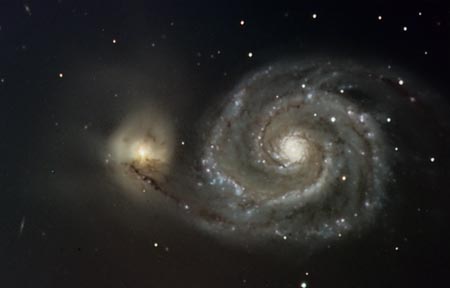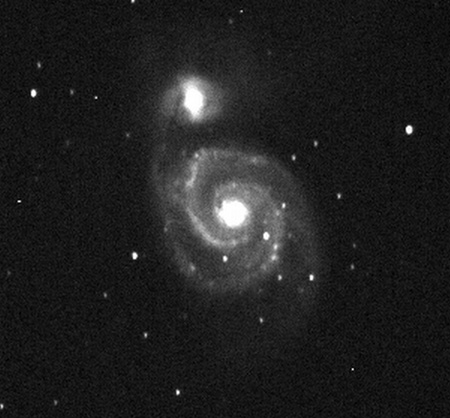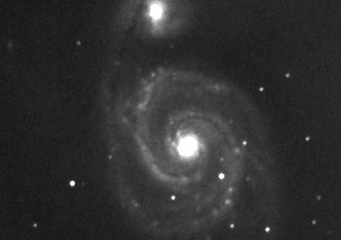Whirlpool Galaxy (M51, NGC 5194)

M51, the Whirlpool Galaxy. Image courtesy Richard Crisp.

M51, taken (shortly before the supernova illustrated below) using a Celestron C-9.25-inch on a Losmandy G11 with Gemini; imager is an SBIG ST9XE with CFW9 filter wheel. Image credit: James A. Hardy.

Animation of M51's most recent supernova using images taken by French observer Stéphane Lamotte Bailey with his 8-in telescope on 30 May 30 and 2 June 2011.
The Whirlpool Galaxy (M51, NGC 5194) is a large, bright spiral galaxy in the constellation Canes Venatici that is interacting with a much smaller neighbor, NGC 5195. The main galaxy was discovered by Charles Messier in 1773, the companion by Pierre Méchain in 1781.
M51 is the first galaxy in which spiral structure was discovered, by Lord Rosse in 1845. This structure, however, has clearly been influenced by the gravitational effect of the companion, which has triggered a huge burst of star formation in the Whirlpool and has also distorted its arms.
M51 is the dominant member of a small group of galaxies that also includes the Sunflower Galaxy (M63) and half a dozen other smaller systems.
| visual magnitude | 8.4 |
| apparent size | 11' × 7' |
| distance | 31 million light-years (9.5 Mpc) |
| position | R.A. 13h 30m 5.1s, Dec. +47° 10' 11" |
Supernovae in M51
M51 has been the scene of three supernovae between 1994 and 2011. The most recent was initially spotted on 31 May 2011, by French amateur astronomer Amédée Riou, and then picked up independently by other observers over the next day or so. Weidong Li and Alex Filippenko, at University of California Berkeley, identified a likely precursor star in Hubble images taken in Apr 2005. Their analysis suggested that the exploding star, designated SN 2011dh, was likely a yellow supergiant of about 20 solar masses and a visual magnitude of 21.8. SN 2011dh was almost certainly a Type II supernova.
Another Type II supernova, named SN 2005cs, occurred six years earlier in M51. A third, somewhat-brighter explosion took place in the same galaxy in 1994.
Extragalactic planet candidate
In 2021, NASA's Chandra X-ray Telescope found evidence for a planet in M51. Planets are much too small to be seen visually across extragalactic distances so it took an unusual event to reveal the presence of this very far-flung world, known as M51-ULS-1. The astronomers who made the discovery were looking for dips in the amount of radiation coming from X-ray bright binaries. These binaries usually consists of a black hole or a neutron star that's orbiting closely around a companion star. The X-rays are given off by matter that's been ripped off the companion and then heated to millions of degrees as it approaches the black hole or neutron star.
Because the region from which the X-rays come is small, it could be blocked from view for a while if a planet in orbit around the binary were to pass in front of it. This is exactly what happened in the case of M51-ULS-1. For three hours the X-ray emission fell to zero: the most likely explanation being the passage, or transit, of a planet in front of the X-ray bright region as seen along our line of sight.
The researchers who made the discovery estimate the planet to be about the same size as Saturn and that it orbits the binary at roughly twice the distance of Saturn from the Sun. It's possible that the event has some other explanation, such as the transit of a cloud of gas and dust, but the data are hard to fit with a cloud-like object.
The planet, if that's what it is, takes about 70 years to complete one orbit so astronomers have a long wait before the next transit. But the discovery raises hopes that more extragalactic planets will be found using the same technique. In fact this is the only method, with the possible exception of microlensing, that's likely to be available in the foreseeable future for finding exoplanets across millions of light-years.


